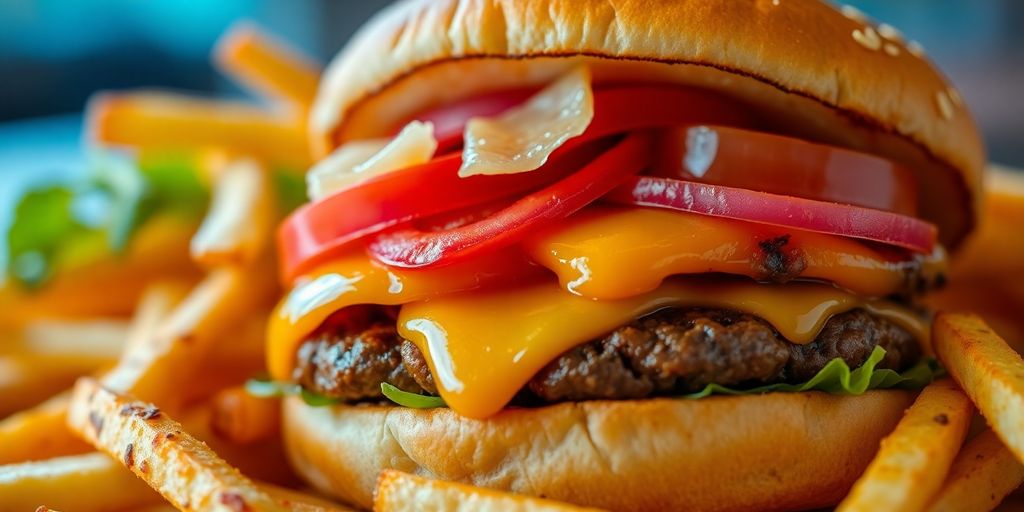Alright, so you’ve got a fast food joint and you want more folks finding you online. That’s where SEO comes in. It’s like making sure your restaurant’s sign is big and bright on the internet. When people search for a quick bite, you want them to see your place first, right? This guide is all about how to do just that with SEO tailored for fast food spots. We’ll cover everything from picking the right words to put on your site to making sure locals can find you easily. Let’s dive in and make your restaurant the go-to spot for hungry customers online.
Key Takeaways
- SEO helps your fast food restaurant get noticed online by more potential customers.
- Choosing the right keywords is essential to rank higher in search results.
- Creating engaging content keeps visitors interested and can improve your site’s SEO.
- Local SEO is crucial for attracting nearby customers to your fast food restaurant.
- Regularly monitoring and tweaking your SEO strategy ensures long-term success.
Understanding SEO Fundamentals for Fast Food Restaurants
Defining SEO and Its Importance
Search Engine Optimization, or SEO, is like giving your fast food joint a megaphone in the bustling online marketplace. It’s about making sure your restaurant is the first thing people see when they’re hungry and searching online. By using SEO, you ensure that when someone types "best fries near me," your place pops up on their screen. This isn’t just about getting clicks—it’s about getting customers through your doors. For fast food spots, this means more foot traffic and, ultimately, more sales.
How Search Engines Work
Search engines are like librarians for the internet. They have a massive collection of web pages and use algorithms to decide which ones to show when someone searches for something. They look at various factors like relevance and quality to rank these pages. For fast food restaurants, understanding these factors can mean the difference between being on the first page of search results or getting lost in the digital shuffle.
The Role of Keywords in SEO
Keywords are the magic words that connect your restaurant to potential customers. Think of them as the terms people type into search engines when they’re looking for a bite to eat. By identifying and using the right keywords, you can make sure your restaurant appears in their search results. It’s like knowing the right catchphrases to get noticed in a crowded room. For instance, using "cheeseburger deals" or "quick lunch spots" can attract those hungry eyes to your menu.
Effective Keyword Selection Strategies
Identifying Relevant Keywords
Finding the right keywords is like setting the foundation for your fast food restaurant’s online presence. Keywords are the terms people type into search engines when they’re looking for a place to eat. To start, think about what dishes are most popular at your place. Are you known for spicy chicken wings or vegan burgers? Make a list of these items and consider how people might search for them. Use tools like Google’s autocomplete feature to see what related searches pop up. This can give you a clue about what potential customers are looking for.
Using Long-Tail Keywords
Long-tail keywords are more specific phrases that might not get searched as often, but they can attract a more targeted audience. For instance, instead of just using "burgers," try "gourmet burgers with avocado". These phrases often have less competition and can help you stand out. Think about what makes your restaurant unique. Is it the location, the ambiance, or a special dish? Incorporate these into your keywords to draw in customers looking for exactly what you offer.
Tools for Keyword Research
There are several tools out there to help you find the best keywords. Google Keyword Planner and SEMrush are popular choices, offering insights into how often certain words are searched and how competitive they are. These tools can guide you in choosing keywords that will boost your visibility. Start by entering a few basic terms related to your restaurant, and let the tool suggest variations. It’s a bit like having a digital treasure map, pointing you to untapped opportunities to enhance your restaurant’s SEO by creating a well-optimized website, implementing a local SEO strategy, and encouraging reviews and visits to strengthen your reputation. Enhance your restaurant’s SEO by creating a well-optimized website, implementing a local SEO strategy, and encouraging reviews and visits to strengthen your reputation.
Picking the right keywords is more than just a technical task; it’s about understanding your customers and speaking their language. When you align your keywords with what people are actually searching for, you make your restaurant easier to find and more appealing to potential diners.
Creating Engaging Content for Your Audience
Importance of Quality Content
Creating content that grabs attention is a must for fast food restaurants. It’s not just about tossing words on a page; it’s about crafting stories that pull people in. Quality content gives your website a heartbeat, making it more than just a menu list. When folks land on your site, they should feel a connection, like they’re already tasting your food. This is where SEO for restaurants plays a crucial role, enhancing your online presence and connecting you with local diners.
Types of Content to Create
You’ve got to mix it up. Think beyond the usual stuff. Sure, your menu needs to be there, but what else? Here are some ideas:
- Blog Posts: Share stories about your restaurant, like how you source your ingredients or tales from the kitchen.
- Behind-the-Scenes Videos: Give a sneak peek into your kitchen or introduce your team.
- Customer Spotlights: Feature stories of your regulars and why they love your place.
Optimizing Menu Descriptions
Your menu descriptions shouldn’t just list ingredients. They should tell a story, painting a picture that makes mouths water. For instance, instead of just saying "Cheeseburger," try "Juicy beef patty topped with melted cheddar cheese and crisp lettuce on a toasted sesame seed bun." Use descriptive language to make your dishes irresistible. This not only attracts hungry eyes but also helps with SEO, as search engines love detailed content.
"Words have the power to transform a simple menu into a journey of flavors, enticing every visitor to become a loyal customer."
On-Page SEO Techniques for Fast Food Websites
Optimizing Title Tags and Meta Descriptions
Getting your title tags and meta descriptions right is like putting a neon sign on your restaurant—it’s what grabs attention. Title tags should be clear and include relevant keywords that reflect the content of the page. For a fast food website, think about what your customers are searching for, like "best burgers in town" or "quick pizza delivery." Meta descriptions are your chance to give a quick pitch—make them engaging and informative, around 150-160 characters, so people know exactly what they’re clicking into.
Utilizing Header Tags Effectively
Header tags, such as H1, H2, and H3, help structure your content and make it digestible. H1 tags should be used for the main title of your page, while H2 and H3 tags break down sections into smaller, more manageable parts. This not only helps search engines understand your content but also makes it easier for users to skim and find what they need. Think of header tags as the table of contents for your site.
Image Optimization Best Practices
Images can make or break your page load times, which is a big deal for SEO. Use compressed images to ensure they load quickly without sacrificing quality. Descriptive file names and alt text are crucial—these should include keywords that describe the image. For example, "cheeseburger_special.jpg" is better than "IMG1234.jpg". Alt text also helps with accessibility, so keep it descriptive yet concise.
In the competitive world of fast food, having a website that’s easy to navigate and quick to load can be the difference between a customer choosing your place or the one down the street. On-page SEO isn’t just about pleasing search engines; it’s about creating a better experience for your visitors.
Leveraging Local SEO for Increased Visibility

Setting Up Google My Business
First off, get your fast food joint listed on Google My Business. It’s a free service that lets you control how your place shows up on Google Search and Maps. Fill in your details like the address, phone number, hours, and menu. Accurate info is key. This step is crucial for optimizing a restaurant’s online presence. Also, ask your happy customers to drop a review. Good reviews can really help your spot stand out in local searches.
Encouraging Customer Reviews
Customer reviews are a big deal in local SEO. Urge your satisfied patrons to leave positive feedback on platforms like Google, Yelp, and Facebook. These reviews don’t just boost your restaurant’s credibility—they also tell search engines that your business is trustworthy. Responding to reviews, whether they’re glowing or not, shows you care about customer feedback and helps build a loyal crowd.
Using Local Keywords
When you’re sprucing up your site for local searches, using local keywords is a must. Toss in your city or neighborhood in your content, meta descriptions, and title tags. Say your fast food place is in Brooklyn, New York, you might use phrases like “best burgers in Brooklyn” or “top pizza spot in Park Slope.” By doing this, you can pull in local customers who are looking for a quick bite nearby.
Local SEO is like putting a bright neon sign on the internet, pointing to your restaurant. It’s about making sure the folks nearby know you’re there and ready to serve up something delicious.
Building Quality Backlinks to Enhance Authority
Understanding Link Building
Link building is like making friends on the internet. It’s about getting other websites to say, "Hey, check out this awesome fast food place!" When they link to your site, it’s like a vote of confidence. These links signal to search engines that your restaurant is a reliable source of information. The more votes you get, the more trustworthy your site appears.
Strategies for Earning Backlinks
- Reach Out to Food Bloggers: Start by contacting food bloggers or influencers in the fast food industry. Offer them a unique experience at your restaurant in exchange for a review or mention.
- Leverage Social Media: Share engaging content on your social media platforms. When followers share your posts, it increases the chances of getting linked back by other sites.
- Submit to Local Directories: List your restaurant in local business directories. These sites often allow free listings and can provide valuable backlinks.
The Importance of Local Links
Local links are like neighborhood endorsements. They tell search engines that your restaurant is a trusted part of the community. Focus on getting links from local news sites, community blogs, or local event pages. This not only boosts your SEO but also draws in local customers who are searching for nearby dining options.
Building backlinks isn’t just about numbers—it’s about quality and relevance. A few links from reputable local sources can be more impactful than dozens from unrelated sites.
For more on the significance and strategies for acquiring high-quality backlinks in 2024, consider exploring further resources to stay ahead in the SEO game.
Monitoring and Adjusting Your SEO Strategy

Using Analytics Tools
To keep your fast food restaurant’s SEO on track, you need to use analytics tools. These tools are like your digital compass, guiding you through the complex world of search engine rankings. They help you understand how many people are visiting your site, which pages they love, and how long they stick around. Without these insights, you’re flying blind.
Here’s a quick list of popular analytics tools you might consider:
- Google Analytics
- SEMrush
- Ahrefs
Each of these tools offers unique features, so it’s worth exploring what fits your needs best.
Tracking Keyword Performance
Once you’ve got your analytics set up, it’s time to focus on keywords. Keywords are the backbone of your SEO strategy. You need to track how well your chosen keywords are performing. Are they bringing in the traffic you expected? Are they helping your site rank higher in search results?
A simple way to track keyword performance is by using a keyword tracking tool. Here’s how you can do it:
- Enter your target keywords into the tool.
- Monitor their ranking over time.
- Adjust your strategy based on the results.
Making Data-Driven Adjustments
Data is your best friend when it comes to SEO. By analyzing the data from your analytics tools, you can make informed decisions about what changes need to be made. Maybe a certain keyword isn’t working out, or perhaps a page needs more engaging content.
"Data doesn’t lie. It tells you where your website stands and what needs to change to improve your online presence."
Here’s a straightforward approach to making adjustments:
- Review your analytics data regularly.
- Identify trends and patterns.
- Implement changes based on your findings.
Incorporating these practices will help ensure your fast food restaurant stays visible and competitive in the digital landscape. For a step-by-step approach to implementing these strategies, check out our beginner’s guide to SEO strategies for restaurants, which utilizes features from the UpMenu website builder.
Conclusion
So, there you have it. SEO isn’t just for tech geeks or big corporations; it’s a game-changer for fast food joints too. By getting the hang of keywords, crafting engaging content, and focusing on local SEO, your burger or pizza place can really shine online. It’s not about overnight success, but with some patience and regular tweaks, you’ll see more folks finding you on the web. Keep at it, and soon enough, your restaurant will be the go-to spot for hungry locals searching for a quick bite. Remember, it’s all about making your place easy to find and hard to forget.
Frequently Asked Questions
What is SEO and why is it important for fast food places?
SEO, or Search Engine Optimization, is a way to help your fast food restaurant show up in online searches. It helps more people find your place when they search for food online, bringing in more customers.
How do I pick the right words to use in SEO?
Choosing the right words, called keywords, is key to good SEO. Think about what words people might type when looking for fast food. Use tools like Google Keyword Planner to find popular search terms.
Why does it take time to see changes with SEO?
SEO isn’t instant; it takes time to work. You might start seeing changes in a few weeks or months. Keep working on it, and you’ll notice more visitors to your website over time.
Do I need to hire an expert to handle SEO for my restaurant?
You can learn SEO on your own, but hiring an expert can be helpful if you’re busy or find it confusing. They can make a plan to boost your online presence faster.
What kind of content should I create for my restaurant’s website?
Create interesting content like blog posts about your food, fun facts, and updates. Also, make sure your menu descriptions are clear and appealing.
How can local SEO help my fast food restaurant?
Local SEO makes sure people nearby can find your restaurant easily. Set up a Google My Business profile and encourage happy customers to leave reviews to boost your local presence.






